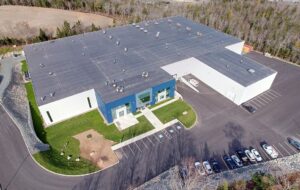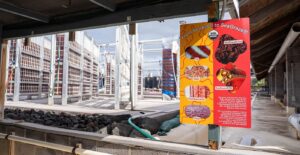Organic food sales are booming. In 2015, the organic market posted a new record of over $43 billion in sales in the US alone. This represents an 11% increase over 2014, far surpassing the 3% annual growth rate of the total food market, according to Organic Trade Association figures.
At the same time, the indoor agriculture industry is gathering momentum. Entrepreneurs in the US and globally are employing technology to grow produce inside warehouses, on top of rooftops, or in smart greenhouses. They say this food is clean, local, and that it will one day provide a sustainable alternative to produce grown outdoors, often miles from consumers. While still a relatively small part of the agtech investment landscape, indoor agriculture startups raised $21m during the first half of this year and there are some very large-scale projects in the works.
Many indoor agriculture operators that use aeroponic, hydroponic or aeroponic production systems, claim their produce is organic, particularly since they use few use chemical inputs like pesticides. To the layman, organic often means chemical-free.
But as a recent movement by some outdoor organic growers to prevent the inclusion of hydroponic operations from the organic register shows, the definition of organic is not all about the use of inputs.
The USDA’s National Organic Program (NOP) is responsible for developing standards that apply to organically-produced agricultural products and is most commonly recognized by the circular green “USDA ORGANIC” seal it gives to thousands of products. For a product to earn the organic seal, it must meet specific and uniform standards set by the program’s advisory National Organic Standards Board.
Folks who think that hydroponics should not be included in the NOP argue that the whole focus of the program is preserving and regenerating soil — a medium typically lacking in these alternative growing methods.
“I think that’s the traditional definition of it, and I have respect for that,” Henry Gordon-Smith co-founder and vice chair of the Association of Vertical Farming told AgFunderNews. “But in the face of climate change and water scarcity, if we want more organic farms, they need to be water-saving, and hydroponics is the best way to save water on farms for certain crops. Conventional ag is draining the soil of all it has.”
How did soil—or the lack thereof—become the focal point of this debate?
When the National Organic Standards Board it first defined the term organic in 1995 it did not encompass alternative growing methodologies that lacked a soil component. The original definition of organic reads: “an ecological production management system that promotes and enhances biodiversity, biological cycles, and soil biological activity.”
Today, the NOP defines organic production as a production system that responds to “site-specific conditions by integrating cultural, biological, and mechanical practices that foster cycling of resources, promote ecological balance, and conserve biodiversity.”
This leaves quite a bit more wiggle room than the earlier definition and shines little light on whether aeroponics, hydroponics or aquaponics fit within the current NOP regime.
According to Sarah Taber, director of food safety at the Aquaponics Association, there is a bigger agenda at play than just keeping the program focused on the soil.
“I think it’s because urban agriculture is starting to become competitive and they are freaking out about losing market share,” Taber tells AgFunderNews. She also sees a social justice issue embedded within the debate.
“These people already own land because they inherited it, or are renting it from people who own land. So when you restrict organics to people who already have access to land you create a ‘haves versus have-nots’ scenario. It’s about wanting to keep the privilege of organic for people who already own land.”
Taber contends that many starting farmers turn to indoor agriculture because of difficulties accessing land—an issue that has come into sharp focus for the USDA as the need to build our next generation of farmers becomes clearer.
What would exclusion mean?
Disagreements aside, would exclusion from the NOP have a big impact on demand for hydroponic-grown produce? Probably not, argue some industry players.
“I think locally grown, year-round produce is the most effective marketing tool and it doesn’t need to be certified. You can use that label without anyone’s permission, and that is most effective,” says Gordon-Smith. The way he sees it, the organic label isn’t the only thing that makes products appealing to consumers. A few themes catch consumers’ attention including transparency, sustainability, and locally-grown. It’s pinpointing the unique and special aspects of each product and building a strong brand and message around those qualities.
These labels can be applied to products without going through what many producers describe as NOP’s lengthy, tedious, and paperwork-intensive organic certification process.
“When you are a soil-based farm that wants to become organic, there is a lot of study of the soil, the history of the farm, farms around it and how they may have affected it,” says Gordon-Smith. “It’s quite an investigation.”
For Jason Green, CEO and co-founder of NY-based aquaponics operation Edenworks, the whole debate about dirt is misguided.
“There is confusion about what organic means but generally, consumers are looking for chemical-free when they buy it,” he says. “But even in organic farming, there are plenty of soil amendments, fertilizers, or pesticides that can be used.”
“Many local farmers without organic certifications are using entirely chemical-free processes. With aquaponics, because we have a system of fish and plants, we do not do have any application of even organic-approved or certified pesticides, or supplemental fertilizers,” he explains.
“Aquaponics is much more aligned with the philosophy of organics, which highlights the irony of potentially creating a ban within the NOP on soilless farming period,” he adds.
When it comes to soil health and regeneration, he doesn’t think the NOP’s existing standards are doing a thorough job of addressing the current challenges.
We can go our own way
And what about the premium price organic producers receive; have indoor ag operators baked these prices into their asset-heavy and capital-intensive business models? No, argues Green, local produce has price parity or close with organic products grown in California, he says.
“We are not particularly threatened by it, but it is more the signal of big organic’s interest in using legislation to protect their market share, which we think is not in the consumer’s’ best interest,” he says.
And demand for local food can outstrip demand for organic certified food among farmers’ market shoppers and even organic shoppers, according to research.
While clearly a disappointment for many growers that presumed they would get organic certification, the industry is not letting this hold it back. In fact, it’s gathering strength in numbers, and the Association of Vertical Farming is working on a sustainability standard for growers to apply for. The standards may encompass factors like social impact, distance to consumers, pesticides, and the presence of re-circulating nutrients in the system.
And if hydroponic, aeroponic or aquaponic growers do go their way with certification, this could even be bad news for the organic industry, argues Gordon-Smith.
“You aren’t getting any innovation around organics if you exclude a whole technological approach,” says Gordon-Smith.
What do you think? Should hydroponic, aeroponic, and aquaponic produce be counted as organic? Or is a separate label more suitable? Email [email protected].




